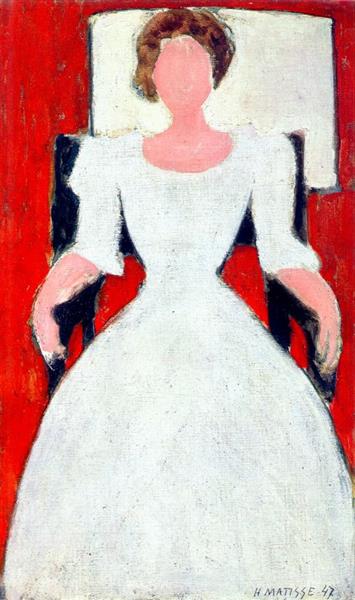Description
In the universe of modern painting, Henri Matisse occupies a preeminent place not only for his audacity in the use of color but also for his ability to capture the essence of his subjects with an economy of lines that defies the apparent complexity of his compositions. The work "Young English Girl" from 1947 is a testament to Matisse's masterful skill in his later phase, a period characterized by a notable evolution towards greater simplicity and clarity in visual language.
The painting shows a young English woman, whose face and figure are delineated with a serenity that contrasts with the vibrant and dynamic background. The simplicity of the pose and the scarcity of details in the portrait give prominence to the highly expressive use of colors. Matisse employs bold and contrasting tones that, together, generate a typically Matissean visual harmony. The sharp black lines that outline the young woman's body and the delicate modeling of her face are complemented by a background dominated by solid and flat colors.
The young woman's facial expression radiates a contemplative, almost melancholic serenity, captured through subtle shading in the eyes and lips. This subtlety in expression is a distinctive mark of Matisse, whose ability to evoke moods and complex personalities with limited means has always been remarkable.
It is crucial in this context to reflect on Matisse's technique in his later years, where the use of cut-out gouache (a technique he coined as "papiers découpés") becomes his distinctive signature. Although "Young English Girl" shows a more traditional application of painting, one can observe a stylistic transition pointing to his later works. This piece is not a découpage, but the simplicity and clarity in the composition clearly foreshadow that final stage of his career.
In "Young English Girl," the isolation of the figure on an apparently undefined background is observed; this background not only highlights the presence of the woman but also infuses the work with an almost metaphysical dimension. It is not a realistic context but an abstract space that could be interpreted as a mental or emotional "place." Matisse invites us to focus all our attention on the central figure, minimizing distractions and suggesting a deeper reflection on the elements of personality and character.
Research on "Young English Girl" must also consider the artist's personal history during this period. In 1947, Matisse was still recovering from cancer surgery that had left him weakened. This period, although physically challenging, was incredibly fruitful from a creative point of view. The painting reflects a certain introspection and tranquility that can be correlated with his state of mind during these years.
In summary, "Young English Girl" represents both technical mastery and profound artistic sense. The precision in the lines, the boldness in the colors, and the aura of introspective serenity emanating from the portrait create a work that is not only visually impactful but also emotionally resonant. It is a perfect example of Henri Matisse's ingenuity in his later years, a period in which, despite his physical limitations, his creative spirit shone with a singular luminescence.

